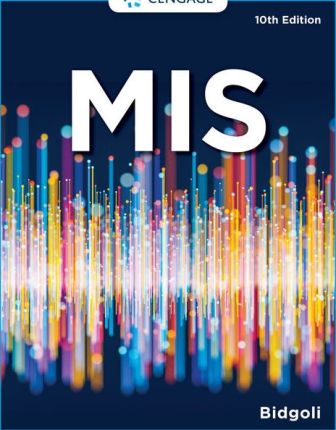This is completed downloadable of Solution Manual for MIS, 10th Edition, Hossein Bidgoli

Product Details:
- ISBN-10 : 0357418697
- ISBN-13 : 978-0357418697
- Author: Hossein Bidgoli
Learn the principles of MIS as you explore the latest developments and industry trends with MIS 10. This practically focused approach helps you master foundational MIS concepts that will guide your career. You examine the latest topics, such as cloud computing, AR/VR, quantum computing and blockchain, with the most current MIS title on the market. Have you ever wondered what you would have done as a company leader in a critical moment? With this edition’s MindTap digital experience, you can strengthen your decision-making skills with “YouDecide” — new interactive case studies that bridge technology and business strategy and position you as the decision maker. You can also examine possible career paths with new career connection videos. Delve deeper into key course concepts with new concept videos and foundational case studies. In addition, MindTap’s RSS feeds alert you to the latest advancements and trends for a stronger focus on today’s real business world.
Table of Content:
- Part 1: Fundamentals of Information Systems
- Chapter 1: Information Systems in Business
- 1-1 Computers and Information Systems in Daily Life
- 1-2 Computer Literacy and Information Literacy
- 1-3 The Beginning: Transaction-Processing Systems
- 1-4 Management Information Systems
- 1-5 Major Components of an Information System
- 1-6 Using Information Systems and Information Technologies
- 1-7 The IT Job Market
- 1-8 Outlook for the Future
- Module Summary
- Key Terms
- Reviews and Discussions
- Projects
- Module Quiz
- Case Study 1-1: Using Information Technologies at Federal Express
- Case Study 1-2: Mobile Technology: A Key Player for Future Shopping
- Chapter 2: Computers and Their Business Applications
- 2-1 Defining a Computer
- 2-2 The History of Computer Hardware and Software
- 2-3 The Power of Computers
- 2-4 Computer Operations
- 2-5 Input, Output, and Memory Devices
- 2-6 Classes of Computers
- 2-7 What Is Software?
- 2-8 Computer Languages
- 2-9 Object-Oriented Programming: A Quick Overview
- Module Summary
- Key Terms
- Reviews and Discussions
- Projects
- Module Quiz
- Case Study 2-1: Become Your Own Banker and Financial Advisor
- Case Study 2-2: iPads: New Productivity Tools for Service Workers
- Chapter 3: Data and Business Intelligence
- 3-1 Databases
- 3-2 Logical Database Design
- 3-3 Components of a DBMS
- 3-4 Recent Trends in Database Design and Use
- 3-5 Data Warehouses
- 3-6 Data Marts
- 3-7 Business Analytics
- 3-8 The Big Data Era
- 3-9 Database Marketing
- 3-10 Tableau and Power BI: Two Popular BI and Visualization Platforms
- Module Summary
- Key Terms
- Reviews and Discussions
- Projects
- Module Quiz
- Case Study 3-1: Data Mining Helps Students Enroll in Courses with Higher Chances of Success
- Case Study 3-2: Data Mining Tools at Pandora Radio
- Chapter 4: Personal, Legal, Ethical, and Organizational Issues
- 4-1 Privacy Issues
- 4-2 Ethical Issues of Information Technologies
- 4-3 The Impact of Information Technology in the Workplace
- 4-4 Green Computing
- Module Summary
- Key Terms
- Reviews and Discussions
- Projects
- Module Quiz
- Case Study 4-1: Telecommuting with a New Twist
- Case Study 4-2: Privacy and Other Legal Issues at Google
- Chapter 5: Protecting Information Resources
- 5-1 Risks Associated with Information Technologies
- 5-2 Computer and Network Security: Basic Safeguards
- 5-3 Security Threats: An Overview
- 5-4 Security Measures and Enforcement: An Overview
- 5-5 Guidelines for a Comprehensive Security System
- Module Summary
- Key Terms
- Reviews and Discussions
- Projects
- Module Quiz
- Case Study 5-1: Vulnerabilities of Medical Devices
- Case Study 5-2: Security Breach at Equifax
- Part 2: Data Communication, the Internet, E-Commerce, and Global Information Systems
- Chapter 6: Data Communication: Delivering Information Anywhere and Anytime
- 6-1 Defining Data Communication
- 6-2 Basic Components of a Data Communication System
- 6-3 Processing Configurations
- 6-4 Types of Networks
- 6-5 Network Topologies
- 6-6 Major Networking Concepts
- 6-7 Wireless and Mobile Networks
- 6-8 Wireless Security
- 6-9 Convergence of Voice, Video, and Data
- Module Summary
- Key Terms
- Reviews and Discussions
- Projects
- Module Quiz
- Case Study 6-1: Data Communication at Walmart
- Case Study 6-2: Protecting the Security and Privacy of Mobile Devices
- Chapter 7: A Connected World
- 7-1 The Internet
- 7-2 Navigational Tools, Search Engines, and Directories
- 7-3 Internet Services
- 7-4 Web Applications
- 7-5 Intranets
- 7-6 Extranets
- 7-7 The Web Trends
- 7-8 The Internet of Everything and Beyond
- Module Summary
- Key Terms
- Reviews and Discussions
- Projects
- Module Quiz
- Case Study 7-1: Scotts Miracle-Gro’s Intranet: The Garden
- Case Study 7-2: Social Networking in Support of Small Businesses
- Chapter 8: E-Commerce
- 8-1 Defining E-Commerce
- 8-2 Major Categories of E-Commerce
- 8-3 B2C E-Commerce Cycle
- 8-4 B2B E-Commerce: A Second Look
- 8-5 Mobile and Voice-Based E-Commerce
- 8-6 E-Commerce Supporting Technologies
- 8-7 E-Commerce and Beyond: Social Commerce
- 8-8 Hypersocial Organizations
- 8-9 Social Media Information Systems
- Module Summary
- Key Terms
- Reviews and Discussions
- Projects
- Module Quiz
- Case Study 8-1: Widespread Applications of Mobile Ads
- Case Study 8-2: Bridging the Gap between E-Commerce and Traditional Commerce
- Chapter 9: Global Information Systems
- 9-1 Why Go Global?
- 9-2 Global Information Systems: An Overview
- 9-3 Organizational Structures and Global Information Systems
- 9-4 Obstacles to Using Global Information Systems
- Module Summary
- Key Terms
- Reviews and Discussions
- Projects
- Module Quiz
- Case Study 9-1: Global Information Systems at Toyota Motor Company
- Case Study 9-2: Information Technologies Support Global Supply Chain
- Part 3: IS Development, Enterprise Systems, MSS, and Emerging Trends
- Chapter 10: Building Successful Information Systems
- 10-1 Systems Development Life Cycle: An Overview
- 10-2 Phase 1: Planning
- 10-3 Phase 2: Requirements Gathering and Analysis
- 10-4 Phase 3: Design
- 10-5 Phase 4: Implementation
- 10-6 Phase 5: Maintenance
- 10-7 New Trends in Systems Analysis and Design
- Module Summary
- Key Terms
- Reviews and Discussions
- Projects
- Module Quiz
- Case Study 10-1: Systems Development at SEB Latvia
- Case Study 10-2: Crowdsourcing Pays Off
- Chapter 11: Enterprise Systems
- 11-1 Supply Chain Management
- 11-2 Customer Relationship Management
- 11-3 Knowledge Management
- 11-4 Enterprise Resource Planning
- 11-5 Cloud-Based Enterprise Systems
- Module Summary
- Key Terms
- Reviews and Discussions
- Projects
- Module Quiz
- Case Study 11-1: ERP at Johns Hopkins Institutions
- Case Study 11-2: CRM at Starbucks
- Chapter 12: Supporting Decisions and Processes
- 12-1 Types of Decisions in an Organization
- 12-2 Decision Support Systems
- 12-3 Executive Information Systems
- 12-4 Geographic Information Systems
- 12-5 Collaboration Systems
- 12-6 Guidelines for Designing a Management Support System
- Module Summary
- Key Terms
- Reviews and Discussions
- Projects
- Module Quiz
- Case Study 12-1: UPS Deploys Routing Optimization with a Big Payoff
- Case Study 12-2: GPS Technology and Analytics Combat Crime
- Chapter 13: Artificial Intelligence and Automation
- 13-1 What Is Artificial Intelligence?
- 13-2 Expert Systems
- 13-3 Case-Based Reasoning
- 13-4 Intelligent Agents
- 13-5 Fuzzy Logic
- 13-6 Machine Learning
- 13-7 Genetic Algorithms
- 13-8 Natural-Language Processing
- 13-9 Integrating AI Technologies into Decision Support Systems
- 13-10 Contextual Computing: Making Mobile Devices Smarter
- 13-11 AI and Automation
- 13-12 Ethical issues of AI
- Module Summary
- Key Terms
- Reviews and Discussions
- Projects
- Module Quiz
- Case Study 13-1: AI-Based Software Helps Businesses Better Understand Customers
- Case Study 13-2: NLP: Making a Smartphone Smarter
- Chapter 14: Emerging Trends, Technologies, and Applications
- 14-1 Trends in Software and Service Distribution
- 14-2 Virtual Reality
- 14-3 Cloud Computing: Foundation, Applications, and Models
- 14-4 Nanotechnology
- 14-5 Blockchain Technology and Cryptocurrency
- 14-6 Quantum Computing
- Module Summary
- Key Terms
- Reviews and Discussions
- Projects
- Module Quiz
- Case Study 14-1: Cloud Computing at Intercontinental Hotels Group (IHG)
- Case Study 14-2: Virtual Reality Enhances Try before You Buy Concept
- Endnotes
- Index





